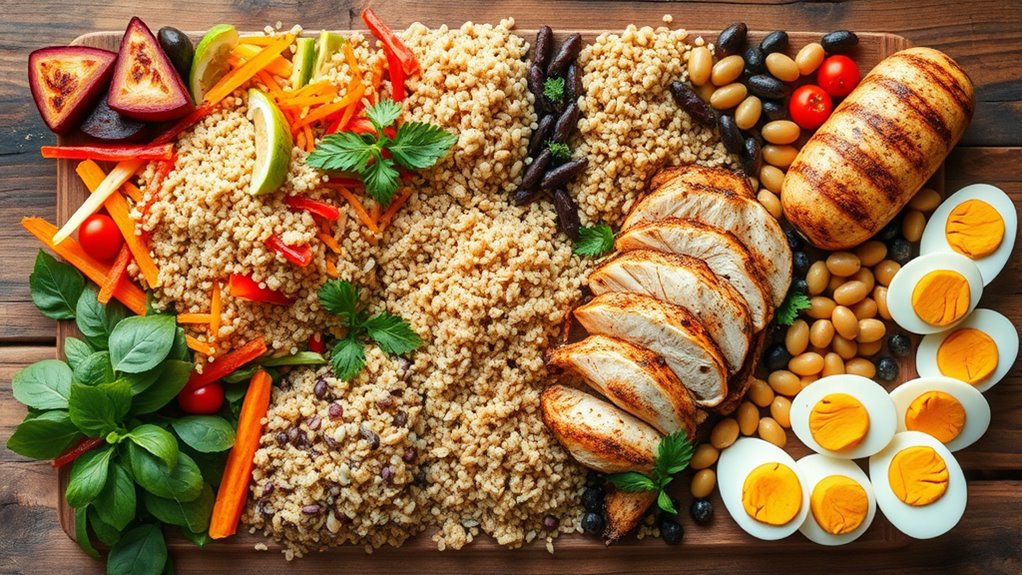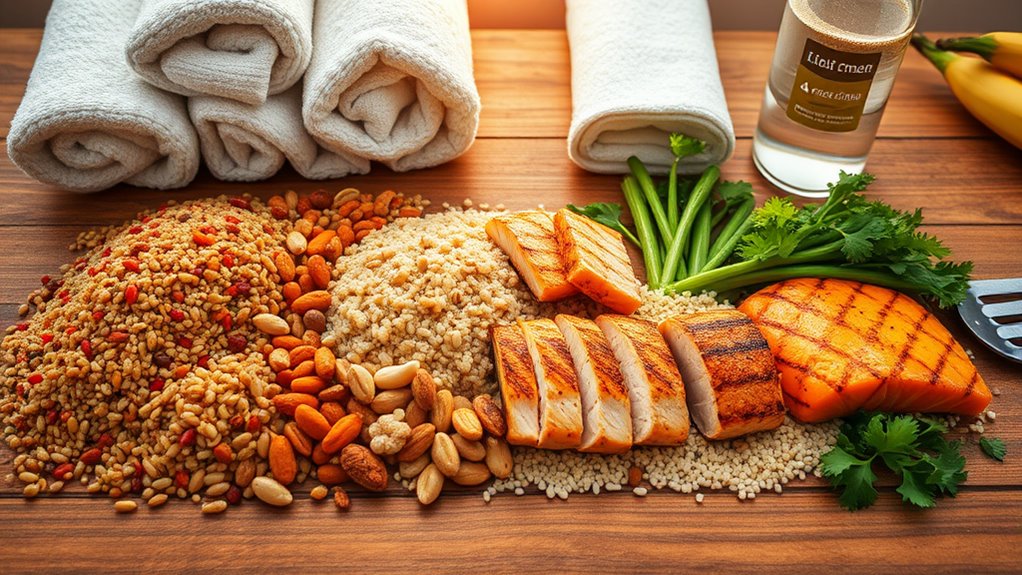
To balance carbs and proteins effectively, first understand your macronutrient needs based on activity levels. Opt for nutrient-dense carbohydrates like quinoa and fiber-rich fruits, alongside lean or plant-based proteins. When planning meals, aim for a plate consisting of 25% protein, 25% carbohydrates, and 50% non-starchy vegetables. Be mindful of portion sizes: use a deck of cards as a guide for proteins and grains. Also, adjust your intake according to physical activity, consuming more carbs when energy demands are higher. By doing so, you’ll discover how to maintain energy while supporting muscle repair and wellness.
Understand Your Macronutrient Needs
Determining your macronutrient needs is essential for maintaining good health and achieving your fitness goals. Understanding how different macronutrients contribute to your overall well-being empowers you to tailor your macronutrient distribution to fit your lifestyle and dietary preferences. Carbohydrates provide you with energy to fuel your adventures, while proteins offer amino acids that help build and repair your muscles. Fats support nutrient absorption and hormone production, keeping everything in balance. Complex carbohydrates, such as those found in grains and legumes, are digested more slowly, providing sustained energy and maintaining stable blood sugar levels. A well-rounded approach avoids the pitfalls of restricting any single nutrient, which can lead to deficiencies and unwanted side effects. Including a variety of nutrient sources such as fruits, vegetables, lean meats, and healthy fats ensures you effectively meet your body’s macronutrient needs. You’ve got the freedom to adjust your diet according to your personal needs, preferences, and activity levels. General guidelines recommend 45-65% carbohydrates, 10-30% protein, and 25-35% fat, but you’re not confined to these suggestions. If you’re an athlete or your daily routine involves high activity levels, consider personalizing your ratios. Listening to your body and refining your diet can lead to powerful outcomes.
Choose Nutrient-Dense Foods
While managing your nutritional choices, prioritizing nutrient-dense foods can dramatically impact your health and energy levels. Embrace the freedom of knowing you’re fueling your body with powerhouse nutrient sources.
Start with nutrient-dense carbohydrates like chia seeds and quinoa, which pack fiber and essential micronutrients. Fruits such as apples and berries aren’t just sweet treats but also offer vitamins and quality carbohydrates, ensuring a steady release of energy. Mingle them with vibrant vegetables like sweet potatoes, which are rich in fiber and vitamins, creating dynamic food combinations to thrill your tastebuds. Fiber regulates nutrient absorption, stabilizes blood sugar, and promotes digestive health, making it a vital component of any balanced diet. Incorporating legumes, like beans and lentils, adds protein and a variety of vitamins and minerals, amplifying your meals with complex carbohydrates.
Looking for protein? Lean meats like chicken breast or turkey offer high-quality protein with minimal fat, keeping you light on your feet. Seas of salmon and tuna bring omega-3 fatty acids to the table, crucial for your heart and brain.
Plant-based proteins like tofu and black beans aren’t only versatile but also packed with iron and fiber, nurturing both body and soul.
Pair whole grains with lean protein sources for beautifully balanced meals that energize. Limit refined carbs—opt for whole foods that stabilize energy.
Plan Balanced Meals

To create balanced meals that nourish and sustain you, focus on incorporating all three essential macronutrients: protein, carbohydrates, and fats. Start by prioritizing whole foods with a variety of colors and textures to enhance your meal prep experience. Incorporate lean proteins, whole grains, and vibrant vegetables in each meal. This not only fuels your body but also liberates you from the monotony of routine eating, allowing you to explore and enjoy diverse flavors. Acknowledge the importance of vitamins and minerals in your diet to ensure optimal metabolic function and overall health.
Aim for balance throughout the day by structuring your main meals—breakfast, lunch, and dinner—to include a thoughtful mix from each food group. Planning meals in advance enables efficient use of time and encourages creativity. Utilize the Plate Method to achieve harmony on your plate:
| Component | Percentage | Example |
|---|---|---|
| Lean Protein | 25% | Grilled chicken |
| Carbohydrates | 25% | Quinoa |
| Non-starchy Veg | 50% | Spinach and broccoli |
Balanced meals help maximize optimal intake of macronutrients, ensuring you receive the right proportions of protein, carbohydrates, and fats. Incorporate plenty of hydration by including water as a staple in your daily routine. Engage your household in the meal planning process, enhancing the variety and joy in shared cooking experiences. Embrace planning efficiency to transform meal prep into a liberating journey of taste and wellness.
Monitor Portion Sizes
Effective portion control is a key component in balancing carbohydrates and proteins in your diet. It empowers you to make conscious choices, freeing yourself from the tyranny of oversized meals.
Begin by understanding serving sizes—think a deck of cards for proteins and grains, and a baseball for vegetables and fruits. This simple comparison provides a grounding visual cue. Measure portions using kitchen tools or your own hands; a fist-sized portion equals about one cup. Carbohydrates, yielding 4 calories per gram, should be measured carefully to maintain balance.
Practice mindful eating by tuning into your internal signals. Pay attention to your hunger and fullness cues, and eat slowly to savor each bite. This awareness helps prevent overeating and fosters a deeper relationship with food. It’s important to remember that balanced meals can be achieved by including three main food groups in each meal.
At home, use smaller dishes to craft the illusion of abundance, and be disciplined about storing leftovers right away to avoid temptation.
Dining out? Don’t be shy to ask for half portions. Eyeball servings and confidently set aside extras for later. Build your meals around MyPlate guidelines, and invite a balance that aligns with your body’s needs.
Liberate yourself from impulsive eating by embracing these portion control techniques—each decision leaving you feeling more in control and empowered.
Adjust to Activity Levels

Understanding how to adjust your carbohydrate and protein intake based on activity levels can considerably enhance your energy management and overall health. Embrace the art of carb cycling to tackle the demands of your active lifestyle. For those engaging in high activity or athletic pursuits, channel 45-65% of your daily calories from carbohydrates to meet your energy needs. Emphasize complex carbs, like whole grains and starchy veggies, especially in meals before any endurance sports or high-intensity sessions, ensuring you perform at your peak. For low-activity days, reel back on the carbs to prevent overloading on calories. It’s this smart balancing act that keeps you feeling light, yet fueled. Meanwhile, don’t neglect the power of protein timing. Muscle repair and recovery hinge on steady protein availability. So, if you’re pushing your limits with endurance training or seeking muscle growth through strength workouts, increase your protein intake. High Intensity Interval Training (HIIT) can lead to significant calorie burn in brief sessions, which supports energy needs and muscle recovery. Aim for high-quality sources like lean meats and plant-based options, and include them in every meal. A protein-rich breakfast sets you up for success, curbing cravings and aligning with your natural rhythms. By mastering these adjustments, you’re embracing a liberated, energized living.
Balance Fosters Optimal Energy
Balancing carbohydrates and proteins is essential for maintaining ideal energy levels and overall health. Carbohydrates are the body’s primary energy source, offering quick fuel through their breakdown into glucose. With limited storage capabilities, they must be consumed in balanced amounts to avoid excess storage as fat.
Proteins, on the other hand, serve primarily in the growth and repair of tissues, contributing to energy only when other sources are insufficient. Both macronutrients, although sharing caloric values at 4 calories per gram, play distinct roles in energy metabolism. Achieving the right balance between the two can greatly influence energy balance and body weight management.
As carbohydrates fuel immediate energy needs and proteins fortify and repair bodily structures, a harmonious balance of these macronutrients maintains energy homeostasis. They’re more closely regulated in energy production and storage compared to fats and must be carefully managed in the diet to prevent imbalances that may lead to weight gain or energy deficiencies.
Additionally, appropriate ratios between carbohydrates and proteins in the diet can help manage hunger, maintain muscle mass, and facilitate effective energy use. Individuals aiming for ideal energy levels and body weight improvement should consider these dynamics in their dietary planning.
Such a balanced approach not only supports sustained energy levels throughout the day but also enhances metabolic efficiency and overall well-being. Understanding the metabolic pathways and the functions of each macronutrient emphasizes the importance of well-planned macronutrient intake for sustaining long-term health and wellness.














